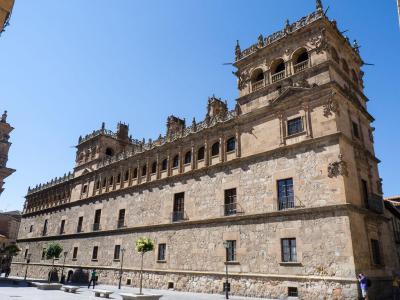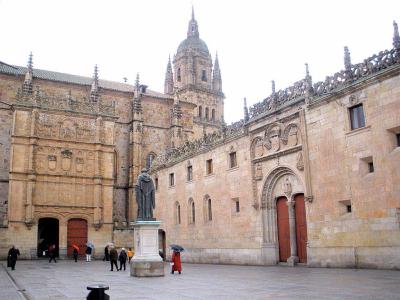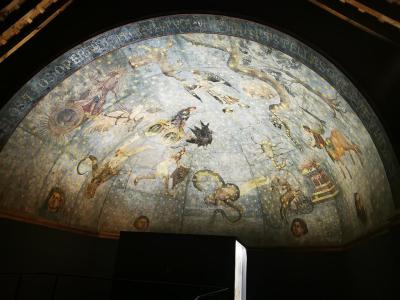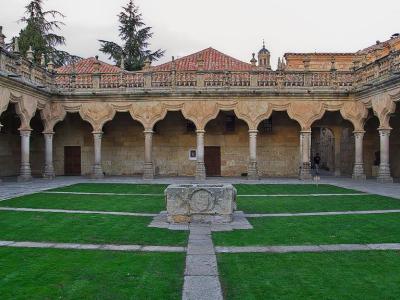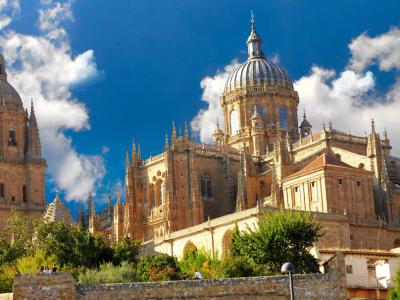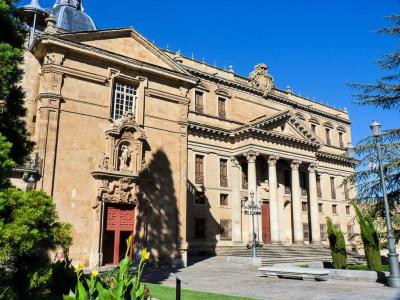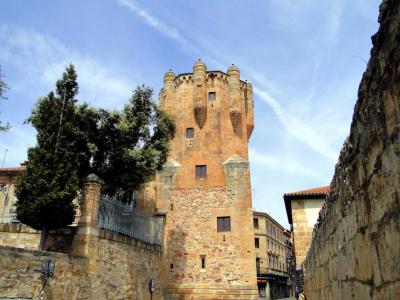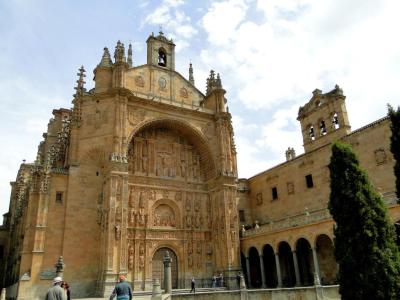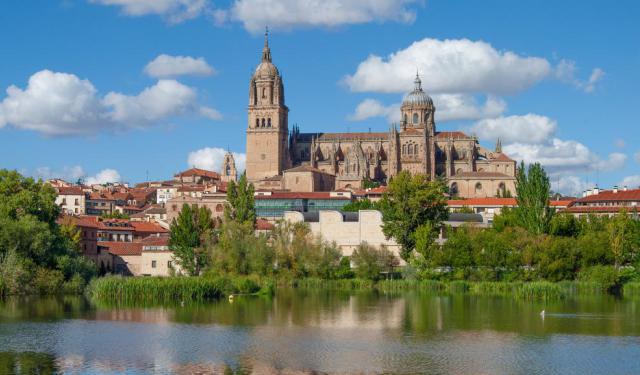
Salamanca's Historical Buildings Walking Tour (Self Guided), Salamanca
Salamanca – one of Spain’s most delightful and intriguing destinations – is a treasure trove of architectural marvels. The abundance of well-preserved, centuries-old wonders of construction tucked away in the labyrinth of narrow lanes in this prestigious university city is truly awe-inspiring. A true feast for the eyes, they are so impressive that the entire historic center of Salamanca was declared a UNESCO World Heritage Site in 1988.
Among the standout attractions here are the Old and New Cathedrals, the magnificent examples of Gothic architecture, whose towering spires and intricate façades leave visitors in awe of their grandeur.
Located near the New Cathedral, the Anaya Palace (Palacio de Anaya), home to the Department of Philology of the University of Salamanca, is an elegant 18th-century edifice that combines Baroque and Neoclassical elements.
The University (Universidad Pontificia de Salamanca) itself, one of Europe's oldest educational institutions, is another architectural gem. The iconic “Sky Over Salamanca” (Cielo de Salamanca) mural adorning the entrance hall of the University's Escuelas Menores building, is very much an attraction in its own right.
Other notable sights include the San Esteban Convent (Convento de San Esteban), with its impressive Plateresque façade and beautiful cloisters, and the Monterrey Palace (Palacio de Monterrey), a Renaissance structure characterized by its elegant façade and elaborate decorative elements.
Described as "a flamboyant ballet of styles," the city of Salamanca, indeed, puts up a grand show in which Gothic spires, Renaissance palaces, and Baroque flourishes pirouette together in a perfect ensemble. If you wish to step into Salamanca's architectural embrace and immerse yourself in a world where time stands still, and each arch and column tells a tale of artistic prowess and stone-masonry brilliance, take this self-guided walking tour.
Among the standout attractions here are the Old and New Cathedrals, the magnificent examples of Gothic architecture, whose towering spires and intricate façades leave visitors in awe of their grandeur.
Located near the New Cathedral, the Anaya Palace (Palacio de Anaya), home to the Department of Philology of the University of Salamanca, is an elegant 18th-century edifice that combines Baroque and Neoclassical elements.
The University (Universidad Pontificia de Salamanca) itself, one of Europe's oldest educational institutions, is another architectural gem. The iconic “Sky Over Salamanca” (Cielo de Salamanca) mural adorning the entrance hall of the University's Escuelas Menores building, is very much an attraction in its own right.
Other notable sights include the San Esteban Convent (Convento de San Esteban), with its impressive Plateresque façade and beautiful cloisters, and the Monterrey Palace (Palacio de Monterrey), a Renaissance structure characterized by its elegant façade and elaborate decorative elements.
Described as "a flamboyant ballet of styles," the city of Salamanca, indeed, puts up a grand show in which Gothic spires, Renaissance palaces, and Baroque flourishes pirouette together in a perfect ensemble. If you wish to step into Salamanca's architectural embrace and immerse yourself in a world where time stands still, and each arch and column tells a tale of artistic prowess and stone-masonry brilliance, take this self-guided walking tour.
How it works: Download the app "GPSmyCity: Walks in 1K+ Cities" from Apple App Store or Google Play Store to your mobile phone or tablet. The app turns your mobile device into a personal tour guide and its built-in GPS navigation functions guide you from one tour stop to next. The app works offline, so no data plan is needed when traveling abroad.
Salamanca's Historical Buildings Walking Tour Map
Guide Name: Salamanca's Historical Buildings Walking Tour
Guide Location: Spain » Salamanca (See other walking tours in Salamanca)
Guide Type: Self-guided Walking Tour (Sightseeing)
# of Attractions: 13
Tour Duration: 2 Hour(s)
Travel Distance: 2.3 Km or 1.4 Miles
Author: nataly
Sight(s) Featured in This Guide:
Guide Location: Spain » Salamanca (See other walking tours in Salamanca)
Guide Type: Self-guided Walking Tour (Sightseeing)
# of Attractions: 13
Tour Duration: 2 Hour(s)
Travel Distance: 2.3 Km or 1.4 Miles
Author: nataly
Sight(s) Featured in This Guide:
- Palacio de Monterrey (Monterey Palace)
- Pontifical University of Salamanca
- Hospital del Estudio (Hospital of Study)
- Cielo de Salamanca (Sky Over Salamanca)
- Escuelas Menores (Minor Schools)
- Catedral Vieja de Santa Maria (Old Cathedral of Salamanca)
- Catedral Nueva de Salamanca (New Cathedral of Salmanca)
- Palacio de Anaya (Anaya Palace)
- Palacio de la Salina (Salina Palace)
- Torre del Clavero (Clavero Tower)
- Convento de las Duenas (Duenas Convent)
- Convento de San Esteban (Convent of St. Stephen)
- Colegio de Calatrava (Calatrava College)
1) Palacio de Monterrey (Monterey Palace)
The Monterrey Palace is a building in the Spanish city of Salamanca, one of the greatest exponents of the Plateresque artistic style. Built by the III Count of Monterrey, it is currently owned by the Casa de Alba, which is the owner of said county. It was a highly admired and imitated building in the 19th century, giving rise to the so-called Monterrey or Neoplateresque style, a historicism that took up the Plateresque aesthetic.
It was declared a National Historic Monument, equivalent to the current term BIC with the category of Monument, on May 6, 1929.2 Since May 2018 the building is open to tourist visits.
The Monterrey Palace was built —in the Italian Renaissance style— by Don Alonso de Zúñiga y Acevedo Fonseca, III Count of Monterrey. Rodrigo Gil de Hontañón and Fray Martín de Santiago drew up the plans for the palace, and Pedro de Ibarra and Pedro de Miguel y Aguirre began construction on January 18, 1539. Since then it would become one of the most representative works of the Spanish Renaissance.
The Monterrey palace has had a notable influence on many Spanish buildings from the 19th and 20th centuries, such as the Palace of the Diputación de Palencia, the work of Jerónimo Arroyo from 1916, the Archaeological Museum of Seville by Aníbal González from 1919 or the Cavalry Academy of Valladolid by Adolfo Pierrad from 1924.
In May 2018 the palace was opened to tourist visits as a museum space. This building houses valuable works of art, as well as a varied collection of furniture, tapestries, porcelain.
It was declared a National Historic Monument, equivalent to the current term BIC with the category of Monument, on May 6, 1929.2 Since May 2018 the building is open to tourist visits.
The Monterrey Palace was built —in the Italian Renaissance style— by Don Alonso de Zúñiga y Acevedo Fonseca, III Count of Monterrey. Rodrigo Gil de Hontañón and Fray Martín de Santiago drew up the plans for the palace, and Pedro de Ibarra and Pedro de Miguel y Aguirre began construction on January 18, 1539. Since then it would become one of the most representative works of the Spanish Renaissance.
The Monterrey palace has had a notable influence on many Spanish buildings from the 19th and 20th centuries, such as the Palace of the Diputación de Palencia, the work of Jerónimo Arroyo from 1916, the Archaeological Museum of Seville by Aníbal González from 1919 or the Cavalry Academy of Valladolid by Adolfo Pierrad from 1924.
In May 2018 the palace was opened to tourist visits as a museum space. This building houses valuable works of art, as well as a varied collection of furniture, tapestries, porcelain.
Sight description based on Wikipedia.
2) Pontifical University of Salamanca
The Pontifical University of Salamanca (in Spanish: Universidad Pontificia de Salamanca) is a private Roman Catholic university based in Salamanca.
This Pontifical University has its origins in the unique University of Salamanca, founded in 1218 and one of the oldest institutions of all Europe and the whole world. Resulting from the resolution of the Spanish kingdom of dissolving the faculties of Theology and Canon Law at the University of Salamanca in 1854, Pope Pius XII decided to establish a new pontifical university and restore those faculties in a new institution. Additional faculties and schools were added over the years.
Olegario González de Cardedal, who received the Ratzinger Prize in 2011, teaches Dogmatic and Fundamental Theology. The University is famous thanks to its faculties of Philosophy, Psychology, Informatics and Education.
This Pontifical University has its origins in the unique University of Salamanca, founded in 1218 and one of the oldest institutions of all Europe and the whole world. Resulting from the resolution of the Spanish kingdom of dissolving the faculties of Theology and Canon Law at the University of Salamanca in 1854, Pope Pius XII decided to establish a new pontifical university and restore those faculties in a new institution. Additional faculties and schools were added over the years.
Olegario González de Cardedal, who received the Ratzinger Prize in 2011, teaches Dogmatic and Fundamental Theology. The University is famous thanks to its faculties of Philosophy, Psychology, Informatics and Education.
Sight description based on Wikipedia.
3) Hospital del Estudio (Hospital of Study)
The Hospital del Estudio (Hospital of Study) of the University of Salamanca, located in the city of Salamanca, is an old hospital that operated from its creation in 1413 until 1810. It currently houses the Rectorate of the University of Salamanca.
The building occupies almost the entire southern front of the Patio de Escuelas with a turn onto Calle de Libreros.
The façade is simple, with a doorway, a gate and several windows. The doorway is Plateresque and has a large semicircular arch that houses two doors with carpanel arches with the figure of Saint Thomas on the tympanum. In the upper part there are three shields: that of Castilla y León in the center and on the sides those of each of the kingdoms.
Due to the shape it has, the column that supports the arches seems to have been reused from another place, and it is to be assumed that the original, in loam stone from Villamayor and in a style more similar to Gothic, suffered damage that made the change necessary. The façade is crowned with a crest that, due to its poor condition, was extensively redone, around 1950, for the celebrations of the VII centenary of the University.
The building occupies almost the entire southern front of the Patio de Escuelas with a turn onto Calle de Libreros.
The façade is simple, with a doorway, a gate and several windows. The doorway is Plateresque and has a large semicircular arch that houses two doors with carpanel arches with the figure of Saint Thomas on the tympanum. In the upper part there are three shields: that of Castilla y León in the center and on the sides those of each of the kingdoms.
Due to the shape it has, the column that supports the arches seems to have been reused from another place, and it is to be assumed that the original, in loam stone from Villamayor and in a style more similar to Gothic, suffered damage that made the change necessary. The façade is crowned with a crest that, due to its poor condition, was extensively redone, around 1950, for the celebrations of the VII centenary of the University.
Sight description based on Wikipedia.
4) Cielo de Salamanca (Sky Over Salamanca)
Cielo de Salamanca (Sky Over Salamanca) is a mural painting attributed to Fernando Gallego that corresponds to the third part of the decoration of the vault of the old Library of the Major Schools of the University of Salamanca, space occupied by the current chapel of San Jerome.
The vault was painted in the 1480s. In the 18th century the other two thirds collapsed during the construction of the chapel, whose vault is four meters below the previous one, hiding the original roof. In 1901 they were rediscovered by Professor García Boiza. In the 1950s, the paintings were removed from the original vault, transferred to canvas and transferred to their current location (University Museum in the Minor Schools) for their contemplation.
This is an astrological representation intended for the teaching of Astrology, probably inspired by the chair of astrology that had recently been established (c. 1460) at the University of Salamanca, which served as support for the practice of Medicine.
The logo of Salamanca 2002 European City of Culture (and currently the logo of the Salamanca City of Culture Municipal Foundation) is inspired by this painting.
The vault was painted in the 1480s. In the 18th century the other two thirds collapsed during the construction of the chapel, whose vault is four meters below the previous one, hiding the original roof. In 1901 they were rediscovered by Professor García Boiza. In the 1950s, the paintings were removed from the original vault, transferred to canvas and transferred to their current location (University Museum in the Minor Schools) for their contemplation.
This is an astrological representation intended for the teaching of Astrology, probably inspired by the chair of astrology that had recently been established (c. 1460) at the University of Salamanca, which served as support for the practice of Medicine.
The logo of Salamanca 2002 European City of Culture (and currently the logo of the Salamanca City of Culture Municipal Foundation) is inspired by this painting.
Sight description based on Wikipedia.
5) Escuelas Menores (Minor Schools)
The Escuelas Menores (Minor Schools), is the building that housed the minor teachings (Bachelor's degree) of university studies.
The construction of this building began in 1428. The façade is very narrow and is located in a corner of the Patio de Escuelas, next to the Hospital del Estudio façade. The entrance is made up of two semicircular arches that rest on a column with a Corinthian capital. In its upper part, there is the imperial coat of arms of Carlos I. The building is organized around a one-story courtyard, whose mixtilinear arches recall those of the Casa de las Conchas; on them there is today a baroque balustrade.
It is currently used for dependencies of the University of Salamanca.
In one of the classrooms in the courtyard, the so-called "Cielo de Salamanca" is currently preserved, which is one third of an extraordinary mural painting attributed to Fernando Gallego that alludes to astronomical and astrological themes.
It dates from the end of the 15th century and was originally located in the vault of the old library (where the chapel is today) of the Escuelas Mayores building, a vault that partly collapsed and the remaining third was covered by that of the new chapel, and moved here after its discovery during construction in the mid-20th century.
The construction of this building began in 1428. The façade is very narrow and is located in a corner of the Patio de Escuelas, next to the Hospital del Estudio façade. The entrance is made up of two semicircular arches that rest on a column with a Corinthian capital. In its upper part, there is the imperial coat of arms of Carlos I. The building is organized around a one-story courtyard, whose mixtilinear arches recall those of the Casa de las Conchas; on them there is today a baroque balustrade.
It is currently used for dependencies of the University of Salamanca.
In one of the classrooms in the courtyard, the so-called "Cielo de Salamanca" is currently preserved, which is one third of an extraordinary mural painting attributed to Fernando Gallego that alludes to astronomical and astrological themes.
It dates from the end of the 15th century and was originally located in the vault of the old library (where the chapel is today) of the Escuelas Mayores building, a vault that partly collapsed and the remaining third was covered by that of the new chapel, and moved here after its discovery during construction in the mid-20th century.
Sight description based on Wikipedia.
6) Catedral Vieja de Santa Maria (Old Cathedral of Salamanca) (must see)
The Old Cathedral's official name is the Cathedral of Saint Mary (Catedral de Santa Maria). The cathedral was founded in 1120 by Salamanca's first bishop, Jerome of Perigord. Construction continued until the final days of the 14th century.
This was an era of transition in many buildings, from Romanesque to Gothic styles. The shift from Romanesque to Gothic is abrupt. Construction of the New Cathedral lasted from 1520 to 1733. The Old Cathedral remained open, and the decision to demolish it was kept on hold.
The cathedral has a basilica plan and a Latin cross. It has three naves and a chevet with three cylindrical apses with semicircular windows. The religious edifice was built with a fortress in mind, but the original battlements are gone.
The impressive dome above the transept is held up by massive pendentives. The outer shape is conical, decorated with scales, and crowned with a rooster weather vane, giving it the name, "Tower of the Rooster." The dome sits on a drum of 16 columns and 32 windows. It was restrengthened in the 19th century to avoid collapse.
Inside, the main 15th-century altarpiece is by artist Nicolas Florentino, who also did the upper fresco of The Last Judgment. The chapel of San Martin is housed in the hollow of the bell tower. There is a painting of Saint Martin sharing his cape with a beggar. The chapel holds several tombs from the 12th and 13 centuries.
There are the Chapels of San Salvador and Santa Barbara on the eastern and southern sides of the old cloister. San Salvador is the oldest. There is a tomb in the center, under the Islamic-style dome. The Chapel of Santa Barbara served as the examination room for bachelor and doctoral candidates.
The chapter rooms of the cloister, built in 1526, house the Cathedral Museum. The Chapel of Santa Catalina dates from the 12th century. The largest room, it is used for cultural events and conferences. The Chapel of San Bartolome holds the tomb of Diego de Anaya, who founded the College of San Bartolome.
This was an era of transition in many buildings, from Romanesque to Gothic styles. The shift from Romanesque to Gothic is abrupt. Construction of the New Cathedral lasted from 1520 to 1733. The Old Cathedral remained open, and the decision to demolish it was kept on hold.
The cathedral has a basilica plan and a Latin cross. It has three naves and a chevet with three cylindrical apses with semicircular windows. The religious edifice was built with a fortress in mind, but the original battlements are gone.
The impressive dome above the transept is held up by massive pendentives. The outer shape is conical, decorated with scales, and crowned with a rooster weather vane, giving it the name, "Tower of the Rooster." The dome sits on a drum of 16 columns and 32 windows. It was restrengthened in the 19th century to avoid collapse.
Inside, the main 15th-century altarpiece is by artist Nicolas Florentino, who also did the upper fresco of The Last Judgment. The chapel of San Martin is housed in the hollow of the bell tower. There is a painting of Saint Martin sharing his cape with a beggar. The chapel holds several tombs from the 12th and 13 centuries.
There are the Chapels of San Salvador and Santa Barbara on the eastern and southern sides of the old cloister. San Salvador is the oldest. There is a tomb in the center, under the Islamic-style dome. The Chapel of Santa Barbara served as the examination room for bachelor and doctoral candidates.
The chapter rooms of the cloister, built in 1526, house the Cathedral Museum. The Chapel of Santa Catalina dates from the 12th century. The largest room, it is used for cultural events and conferences. The Chapel of San Bartolome holds the tomb of Diego de Anaya, who founded the College of San Bartolome.
7) Catedral Nueva de Salamanca (New Cathedral of Salmanca) (must see)
In 1509 Ferdinand II of Aragon perceived the Old Cathedral of Salamanca to be "small, dark, and low." He ordered architects Anton Egas and Alonso Rodriguez to drop everything in Toledo and Seville and proceed to Salamanca to lay out a new temple.
The New Cathedral, after much discussion, was to be laid out parallel to the Old Cathedral. It was built in the Gothic style with frank stone from Villamayor. It has a rectangular floor plan with three central naves and two extra naves with niched side chapels. The header end is rectangular, forming a hall plan.
Work was halted through most of the 17th century and completed in 1733. All this suffered some devastation from the Lisbon earthquake of 1755. Afterward, the dome was done over, and the bell tower was strengthened.
The catastrophe is remembered today with a traditional popular ceremony called, "Mariquelo." When the earthquake of 1755 made itself felt in Salamanca, the people huddled in the Cathedral, seeking Heaven's protection. The Cathedral stood, and no one died. The Cathedral Council felt there was a divine pattern to it all.
The Council ordered that each year on October 31st, a Mariquelo family member should climb to the top of the Cathedral to ring the bells in gratitude to God and also, to check on the inclination of the tower, which had developed a slight list. The Mariquelos had been living in the Cathedral, so they got the job.
In 1976 the last member of the clan made the ascent of the tower, and the tradition fell into disuse. In 1985 however, it was revived. Today, a man dressed as a cowboy (charro) climbs the tower, carrying bagpipes and drums. The bell rings, and the people in the square thank God and pray for peace.
The New Cathedral, after much discussion, was to be laid out parallel to the Old Cathedral. It was built in the Gothic style with frank stone from Villamayor. It has a rectangular floor plan with three central naves and two extra naves with niched side chapels. The header end is rectangular, forming a hall plan.
Work was halted through most of the 17th century and completed in 1733. All this suffered some devastation from the Lisbon earthquake of 1755. Afterward, the dome was done over, and the bell tower was strengthened.
The catastrophe is remembered today with a traditional popular ceremony called, "Mariquelo." When the earthquake of 1755 made itself felt in Salamanca, the people huddled in the Cathedral, seeking Heaven's protection. The Cathedral stood, and no one died. The Cathedral Council felt there was a divine pattern to it all.
The Council ordered that each year on October 31st, a Mariquelo family member should climb to the top of the Cathedral to ring the bells in gratitude to God and also, to check on the inclination of the tower, which had developed a slight list. The Mariquelos had been living in the Cathedral, so they got the job.
In 1976 the last member of the clan made the ascent of the tower, and the tradition fell into disuse. In 1985 however, it was revived. Today, a man dressed as a cowboy (charro) climbs the tower, carrying bagpipes and drums. The bell rings, and the people in the square thank God and pray for peace.
8) Palacio de Anaya (Anaya Palace)
Palacio de Anaya (Anaya Palace) is one of the few buildings in Salamanca in neoclassical style. It owes its name to Diego de Anaya Maldonado, founder of the Colegio de San Bartolomé in 1401. Its works began in 1760, to replace the previous building of the Colegio Mayor de San Bartolomé, badly damaged in the Lisbon earthquake of 1755. Its creators were José from Hermosilla and Juan de Sagarvinaga. Its most striking elements are the façade and the imperial staircase inside the palace, where there is also an interesting bust of Miguel de Unamuno, made by Victorio Macho in 1930.
After the suppression of the university colleges, the building had various uses, including Civil Government, which is why it is currently known as a palace, although it is actually a college.
The Anaya Palace currently houses the Faculty of Philology of the University of Salamanca.
Next to the school is the Hospedería, 1715, by Joaquín Churriguera, which housed students who paid for their studies by serving other noble and wealthy students who occupied the College. Today it is used for classrooms and offices, and its old stables house the Faculty cafeteria.
The baroque church of San Sebastián, formerly the school chapel and currently the Cathedral Parish, is also attached.
After the suppression of the university colleges, the building had various uses, including Civil Government, which is why it is currently known as a palace, although it is actually a college.
The Anaya Palace currently houses the Faculty of Philology of the University of Salamanca.
Next to the school is the Hospedería, 1715, by Joaquín Churriguera, which housed students who paid for their studies by serving other noble and wealthy students who occupied the College. Today it is used for classrooms and offices, and its old stables house the Faculty cafeteria.
The baroque church of San Sebastián, formerly the school chapel and currently the Cathedral Parish, is also attached.
Sight description based on Wikipedia.
9) Palacio de la Salina (Salina Palace)
Beware the Archbishop's revenge! Legend has it that in the 16th century, Archbishop Alonso de Fonseca visited Salamanca to attend a diocesan council. He was traveling with his mistress, Lady Juana Pimentel. When he asked for hospitality for himself and Juana, the disapproving nobles refused. The Archbishop had to be avenged.
Alonso caused the Palacio to be built and decorated with huge corbels of grotesque images of writhing, tortured figures showing great pain. It's true Alonso and Juana were an item, but the revenge story is fake.
Salina Palace (Palacio de la Salina) was ordered by Don Rodrigo de Messía, Lord of La Guardia, who was married to Doña Mayor de Fonseca and Toledo. Dona Mayor bequeathed the mansion to her second son, Juan Alonso de Fonseca. This is why the Fonseca coat of arms is on the facade of the building, and the palace is also called the Fonseca Palace (Palacio de Fonseca).
Salina Palace, built in 1538, is in the Plateresque style and shows Italian elements. It has a light, open facade, a patio with a gallery of arches, capitals, and the aforementioned monstrous corbels supporting the courtyard balconies. The architect was Rodrigo Gil de Hontanon.
The building was originally intended as a salt warehouse, hence the name "Salina." It was the headquarters of the Salt state monopoly until 1870. Juan Alonso was certainly the salt concessionaire of the city. Since 1884 Salina Palace has housed the Provincial Council.
Alonso caused the Palacio to be built and decorated with huge corbels of grotesque images of writhing, tortured figures showing great pain. It's true Alonso and Juana were an item, but the revenge story is fake.
Salina Palace (Palacio de la Salina) was ordered by Don Rodrigo de Messía, Lord of La Guardia, who was married to Doña Mayor de Fonseca and Toledo. Dona Mayor bequeathed the mansion to her second son, Juan Alonso de Fonseca. This is why the Fonseca coat of arms is on the facade of the building, and the palace is also called the Fonseca Palace (Palacio de Fonseca).
Salina Palace, built in 1538, is in the Plateresque style and shows Italian elements. It has a light, open facade, a patio with a gallery of arches, capitals, and the aforementioned monstrous corbels supporting the courtyard balconies. The architect was Rodrigo Gil de Hontanon.
The building was originally intended as a salt warehouse, hence the name "Salina." It was the headquarters of the Salt state monopoly until 1870. Juan Alonso was certainly the salt concessionaire of the city. Since 1884 Salina Palace has housed the Provincial Council.
10) Torre del Clavero (Clavero Tower)
The Torre del Clavero (Clavero Tower) is one of the most typical and well-known monuments of the city of Salamanca. It was declared a national monument on June 3, 1931.
Rest of the manor house of the clavero of the Order of Alcántara. It brings together the interest of the military fortress and the constructive beauty of the XV century. The tower is square in plan with about 28 meters high. At about 20 meters the tower acquires an octagonal shape, adorned on each side with a semi-cylindrical drum surmounted by a coat of arms.
The Clavero tower is beautiful and graceful with its lines, with its ochavas loaded with sentry boxes, its irregular holes, its cornice of small arches and modillions and its shields of the Sotomayor and Anaya family, raise the question of whether it was built by order of Don Francisco de Sotomayor, clavero of the Order of Alcántara, in 1470, or Don Fray Diego de Anaya.
Rest of the manor house of the clavero of the Order of Alcántara. It brings together the interest of the military fortress and the constructive beauty of the XV century. The tower is square in plan with about 28 meters high. At about 20 meters the tower acquires an octagonal shape, adorned on each side with a semi-cylindrical drum surmounted by a coat of arms.
The Clavero tower is beautiful and graceful with its lines, with its ochavas loaded with sentry boxes, its irregular holes, its cornice of small arches and modillions and its shields of the Sotomayor and Anaya family, raise the question of whether it was built by order of Don Francisco de Sotomayor, clavero of the Order of Alcántara, in 1470, or Don Fray Diego de Anaya.
Sight description based on Wikipedia.
11) Convento de las Duenas (Duenas Convent)
The Convento de las Dueñas (Duenas Convent) is a Dominican convent located in the city of Salamanca. It was built in the 15th and 16th centuries. The convent was founded in 1419 by Juana Rodriguez Maldonado in her own palace. The church and the cloister were built around 1533. The convent preserves some of the original mudejar gates of the palace. One of them leads to the cloister. The capitals of the upper storey are among the more prominent examples of the Plateresque.
Sight description based on Wikipedia.
12) Convento de San Esteban (Convent of St. Stephen)
The Convento de San Esteban (Convent of Saint Stephen) is a Dominican monastery situated in the Spanish city of Salamanca.
The Dominicans settled in Salamanca in about 1255, but their original monastery was demolished to construct the parish church of Saint Stephen in 1524, at the initiative of Cardinal Juan Álvarez de Toledo. Construction took until 1610, and involved Martin de Santiago, Rodrigo Gil de Hontañón, Juan Ribero Rada and Pedro Gutiérrez. However, the layout and design are by Juan de Álava, who began the work in 1524, as evidenced by a plan in his possession.
Rodrigo Gil de Hontañón was involved with the transepts and the dome. Although the church is considered to be an excellent example of the Plateresque style, the long period of construction explains the mixture of styles ranging from Gothic to the late Baroque, the latter not so noticeable in the architecture but very apparent in the reredos of the main altar by José de Churriguera. According to tradition, Christopher Columbus stayed in this monastery (actually in the earlier building it replaced) when he came to Salamanca to defend his idea of reaching the Indies by sailing west, against the geographers of the University.
During the Counter Reformation it was an important center for the Dominicans who founded the School of Salamanca, headed by Francisco de Vitoria.
The Dominicans settled in Salamanca in about 1255, but their original monastery was demolished to construct the parish church of Saint Stephen in 1524, at the initiative of Cardinal Juan Álvarez de Toledo. Construction took until 1610, and involved Martin de Santiago, Rodrigo Gil de Hontañón, Juan Ribero Rada and Pedro Gutiérrez. However, the layout and design are by Juan de Álava, who began the work in 1524, as evidenced by a plan in his possession.
Rodrigo Gil de Hontañón was involved with the transepts and the dome. Although the church is considered to be an excellent example of the Plateresque style, the long period of construction explains the mixture of styles ranging from Gothic to the late Baroque, the latter not so noticeable in the architecture but very apparent in the reredos of the main altar by José de Churriguera. According to tradition, Christopher Columbus stayed in this monastery (actually in the earlier building it replaced) when he came to Salamanca to defend his idea of reaching the Indies by sailing west, against the geographers of the University.
During the Counter Reformation it was an important center for the Dominicans who founded the School of Salamanca, headed by Francisco de Vitoria.
Sight description based on Wikipedia.
13) Colegio de Calatrava (Calatrava College)
The Colegio de la Inmaculada Concepción de Calatrava, commonly called Colegio de Calatrava (Calatrava College), is the only college founded in Salamanca by the military orders whose building still stands; belonged to the Order of Calatrava.
Established as an imperial college in 1552 by Carlos V and incorporated into the University of Salamanca in 15541; The construction of this building did not begin until 1717, by Joaquín de Churriguera who directed the works until his death in 1724. In 1750 the works resumed directed by Jerónimo García de Quiñones. He was forced to eliminate the baroque ornaments of the original project due to the prevailing neoclassical ideas at that time, especially those wanted to be imposed by Francisco Ibáñez de Corbera, rector of the school when it was consecrated in 1790. In the War of Independence the canvases disappeared of Goya that was in the altarpieces.
The façade has two bodies and is articulated by giant order pilasters and topped with a balustrade. The decorative elements that adorn it are mostly Renaissance-inspired. In the decoration, we notice truly baroque mixtilinear elements around the main doorway, in the doors of the side towers and in the moldings that surround all the windows of the façade.
Today it is the headquarters of the Casa de la Iglesia, an institution that houses the dependencies of the Diocese of Salamanca.
Established as an imperial college in 1552 by Carlos V and incorporated into the University of Salamanca in 15541; The construction of this building did not begin until 1717, by Joaquín de Churriguera who directed the works until his death in 1724. In 1750 the works resumed directed by Jerónimo García de Quiñones. He was forced to eliminate the baroque ornaments of the original project due to the prevailing neoclassical ideas at that time, especially those wanted to be imposed by Francisco Ibáñez de Corbera, rector of the school when it was consecrated in 1790. In the War of Independence the canvases disappeared of Goya that was in the altarpieces.
The façade has two bodies and is articulated by giant order pilasters and topped with a balustrade. The decorative elements that adorn it are mostly Renaissance-inspired. In the decoration, we notice truly baroque mixtilinear elements around the main doorway, in the doors of the side towers and in the moldings that surround all the windows of the façade.
Today it is the headquarters of the Casa de la Iglesia, an institution that houses the dependencies of the Diocese of Salamanca.
Sight description based on Wikipedia.
Walking Tours in Salamanca, Spain
Create Your Own Walk in Salamanca
Creating your own self-guided walk in Salamanca is easy and fun. Choose the city attractions that you want to see and a walk route map will be created just for you. You can even set your hotel as the start point of the walk.
Salamanca Introduction Walking Tour
Polybius, the ancient Greek historian, called it "Helmantike." Another ancient Greek historian, Plutarch, opted for "Salmatike." The word "Salamanca" itself refers to a "cave," "grotto," or "dark place." Legend says Satan taught Black Magic in the Caves of Salamanca.
Salamanca's splendor began with the royal charter of Alfonso IX... view more
Tour Duration: 1 Hour(s)
Travel Distance: 1.6 Km or 1 Miles
Salamanca's splendor began with the royal charter of Alfonso IX... view more
Tour Duration: 1 Hour(s)
Travel Distance: 1.6 Km or 1 Miles
The Most Popular Cities
/ view all
